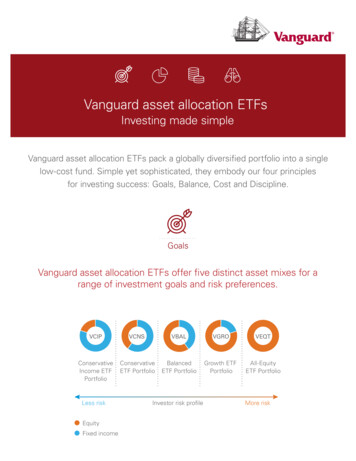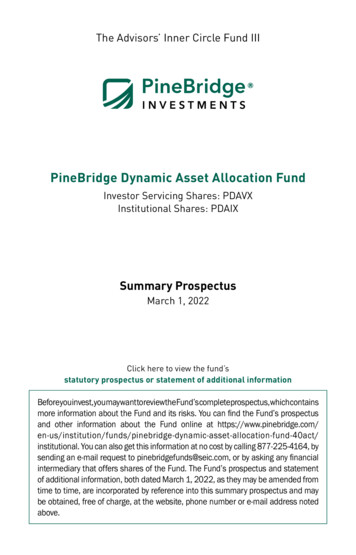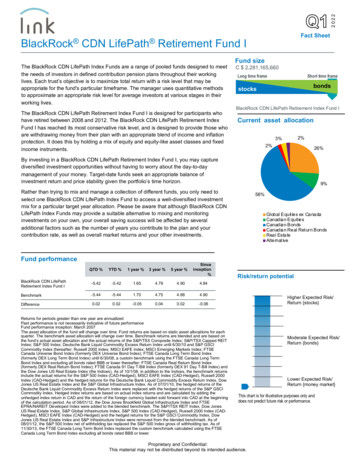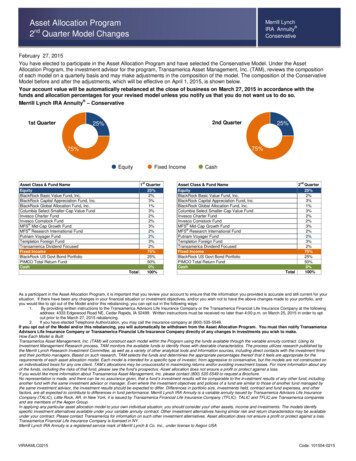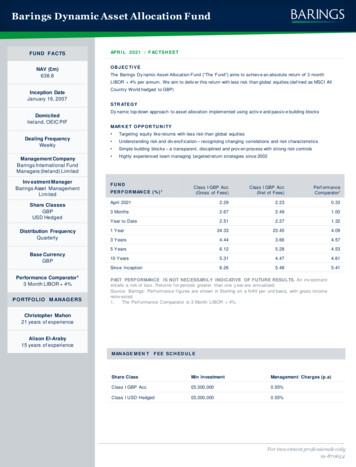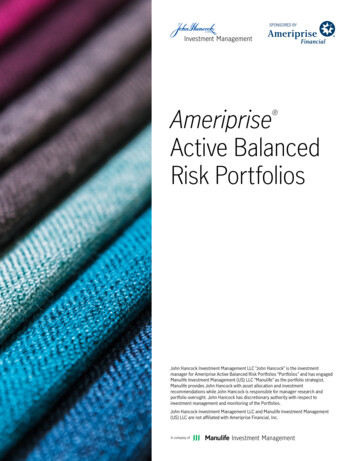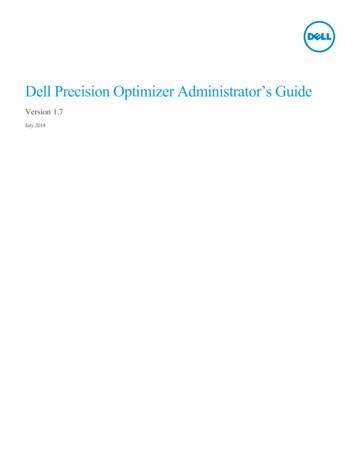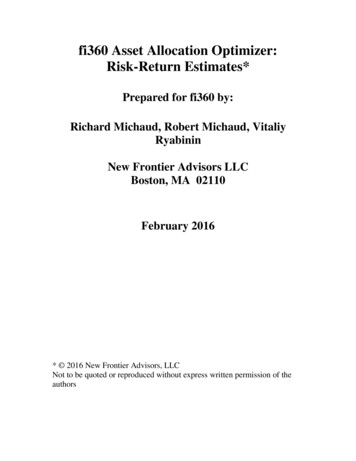
Transcription
fi360 Asset Allocation Optimizer:Risk-Return Estimates*Prepared for fi360 by:Richard Michaud, Robert Michaud, VitaliyRyabininNew Frontier Advisors LLCBoston, MA 02110February 2016* 2016 New Frontier Advisors, LLCNot to be quoted or reproduced without express written permission of theauthors
This report provides risk-return estimates for twelve asset classes for use with the fi360Asset Allocation Optimizer. The risks and returns are computed from long-termhistorical data overlaid with financial theory and adjusted for current interest rates. Thereturns represent “equilibrium” market estimates relative to the selected optimizationuniverse adjusted for short-term market rates for contemporary realism. A marketequilibrium approach is designed to provide a longer term perspective on capital marketrates by limiting period-dependence as well as avoiding ad hoc “building block” methodsin current usage. The estimates are useful to illustrate properties of optimized portfoliosfor Markowitz (1959) mean-variance (MV) and Michaud and Michaud (2008) meanvariance (MV) optimization methodologies. While also useful as a framework forcomparative purposes relative to a given set of forecasts, judgment is required forapplication to an investment program.1Indices and Historical Return DataHistorical returns of major stock and bond capital market indices are the starting pointsfor estimating asset risks and returns for asset allocation studies. Reliable index returnsare available from 1926 for a few major asset classes.2Column 1 in Table 1 lists the twelve asset classes in the fi360 asset allocationdemonstration system. Column 2 in Table 1 lists the actual index data used as the proxyfor the indicated asset class.3 Column 3 displays the starting point of the series ofmonthly returns for each index. The ending point for the monthly data used in the studyis December 2015.Monthly returns are statistically convenient for reliable estimation of correlations. Thechoice of representative index may often require some compromise of longevity versusrelevance and representativeness for the asset class.Major U.S. Indices and Return PremiumsReliable major U.S. capital market monthly historical stock and bond index returns havebeen available since 1926.4 Inflation and short-term interest rates vary widely over along-term historical period. To improve estimate relevance it is generally appropriate tocompute historical risk-return estimates relative to inflation or short-term interest rates.These real risk-return estimates can then be redefined in current nominal terms by theaddition of current interest rates.1In practice markets are not in equilibrium. More fundamentally, any set of risk-return estimates aregenerally useful primarily for a targeted group of investors. Risk-return estimates vary by institution and byinvestor considerations such as objectives, horizons, funds for investment, and risk aversion.2Ibbotson (2014), Morningstar Principia (2015).32011-2015 index returns are taken from Morningstar Principia for the corresponding Ibbotson indices.4The Center for Research in Security Prices (CRSP) stock return databases began in 1926. Original studiesof CRSP stock market returns and risk include Fisher and Lorie (1968, 1970).2
Table 1Asset Classes, Indices, Range of Monthly ReturnsAsset ClassFixed IncomeIntermediate Term BondLong Term BondHigh Yield BondsInternational Govt BondsCommoditiesLarge Cap EquityMid Cap EquitySmall Cap EquityInternational EquityEmerging Market EquityREITsIndexSBBI 30 day US Treasury BillBarcap U.S. Interm. Gov/Credit BondBarcap U.S. Long Gov/Credit BondCredit Suisse High Yield Bond IndexCitigroup World Gov Bond ex USGold, London PM FixSBBI Large Company StocksRussell Mid CapSBBI Small Company StocksMSCI EAFEMSCI Emerging MarketsDJ US Select REITBeginning eb-79Jan-26Jan-70Jan-88Jan-78The average annualized monthly return of large capitalization U.S. stocks from 1926through 2015 is 11.3% with a standard deviation of 18.8%. T-bill returns averaged 3.4%for the period with a 0.9% standard deviation. The large cap and T-bill return premiumrelative to inflation (CPI) for the period is 8.5% and 0.5% respectively with 19.0% and1.8% standard deviations. T-bills have a 0.08 CPI relative correlation with large capequity indices over this time period.5Relevant Index ReturnAsset risk-return estimation requires addressing the relevance of historical return data.While long term historical returns are available for a few asset classes from the early andmid-twentieth century, it is of interest to consider whether it is very relevant forinvestment purposes in the early twenty-first century. Revolutionary developments haveoccurred in communications, derivatives, regulation, accounting, politics, investmentstrategies, and economics in the last ten to twenty years. Many international and fixedincome indices have no reliable return data prior to 1970. In addition, the gold standard –in effect prior to 1973 – seriously compromises the estimation of correlations amongmany asset classes. On the other hand, statistical reliability, particularly with respect tocorrelation estimation and return premiums require as much long-term data as isreasonable.To satisfy these competing priorities we begin our estimation period with the availabilityof reliable international equity data unaffected by the gold standard. We use January1973 as the starting point for our data set. As Table 1 indicates, many of the indices inthe study have missing data over the 1973 to 2015 period. The most affected are highyield bonds, international government bonds, and emerging equity markets. Our studyuses a sophisticated maximum likelihood statistical procedure designed to consistently5Estimates are Ibbotson stocks, bonds, bills and inflation. Ibbotson SBBI 2011 Classic Yearbook,Chicago, Il. 2011-2015 returns are from Morningstar Principia.3
and holistically estimate risk-return parameters in the presence of missing data.6 Thismissing data algorithm avoids arbitrary decisions for parameter estimation common inmany prior asset allocation studies.7Geometric versus Arithmetic ReturnsOne of the more enduring misunderstandings of estimating risks and returns for assetallocation optimization is the confusion between geometric, or compound, and arithmeticreturns. A familiar example demonstrates the difference between the arithmetic andgeometric mean of returns. Assume a 100% return followed by a -50% return. Thearithmetic mean return over the two periods is 25% but a dollar grows to 2 dollars andends up at 1 dollar at the end of the second period. The geometric mean gives the correctmeasure of return over the two periods, 0%.Which return measure, arithmetic or geometric, is appropriate as a basis for defining riskand return for portfolio optimization? As Michaud (1981, 2003) shows, the geometricmean is a function of the length of the investment horizon as well as the returndistribution. In contrast, the arithmetic mean is a measure of centrality that does notdepend on the investment horizon. The arithmetic mean is the measure of choice forportfolio optimization. From a practical point of view, the geometric mean typicallyunderestimates investment return and may lead to unrealistic risk-averse investmentdecisions.Index Choice and Risk-Return EstimatesThe long-term U.S. indices are from Ibbotson. Intermediate and Long Term Bonds areBarclays Capital U.S. Intermediate and Long Government Credit Bonds respectively8.The Russell Midcap index is available from 1979.9 The Morgan Stanley CapitalInternational (MSCI) Europe Asia and Far East (EAFE) and Emerging Market indices areused for defining risk-return estimates for non-U.S. stocks.10 These are standards forinternational investment, as extensively available as any other set of indices, andmanaged relative to float, investability and other issues of concern in foreign markets.The CSFB Credit Suisse High Yield and Citigroup WGBI non-U.S. Government Bondindex are relevant long-lived bond indices.11 The Dow Jones US Select REIT12 index is arelevant long-lived REIT index. The London, PM Fix gold index may usefully represent6A standard reference is Carlin and Louis (1992). The investment problem raised with any missing dataestimation procedure is that the existence of an index would have modified the investment environment andmay have affected other index returns.7See the discussion on the use of the EM algorithm in Michaud et al (2006).8Morningstar Principia 2015 Morningstar Inc. Barclays Capital U.S. Gov. Credit Bond Indices areformerly Lehman Brothers US Gov. Credit Bond Indices.9Russell Investment Group. “U.S. Equity Index Values.” ndexes/fact-sheet.page?ic US5015 (2015).10Morgan Stanley Capital International. "Equity Indices.” ernational equity indices/performance.html (2015).11Morningstar Principia 2015 Morningstar Inc.12The DJ Wilshire REIT index is now known as The Dow Jones US Select REIT index.4
commodities.13 The MSCI Emerging Markets index, available since January 1988, is theshortest period index. The 1973-2015 historical period provides sufficient historicalreturn data for risk-return estimation. Table 2 summarizes our historical CPI adjustedrisk and return estimates.Table 2Annualized CPI Relative Risk-Return Estimates: 1973-2015Asset ClassesFixed IncomeIntermediate Term BondLong Term BondHigh Yield BondsInternational Govt BondsCommoditiesLarge Cap EquityMid Cap EquitySmall Cap EquityInternational EquityEmerging Market EquityREITsReturn (%)Std. Deviation 08.310.219.715.517.521.317.423.618.9Equilibrium Return EstimationHistorical return estimates typically reflect time-period dependent results that are unlikelyto be useful for long-term investment objectives. For example, Table 2 reports thatinternational equity has a lower estimated return than REITs, a result that many investorswill think unlikely to persist over any significant future time period. Various ad hocmethods such as additive “building blocks” based on historical market premiums havebeen proposed to reduce period-dependent results in risk-return estimation. Ourestimates are based on fundamental principles of capital market functioning. The use ofthe Security Market Line (SML) framework of the Capital Asset Pricing Model (CAPM)provides a financially relevant framework for limiting near-term period-dependentresults.We estimate SML returns from beta relationships relative to the market portfolio. Theprocedure uses linear regression of historical asset returns relative to a capitalizationweighted global equity market proxy for CPI relative data.14 CAPM SML returnestimates are calculated from their estimated betas and the 6.0% return premium fromTable 2. The regression results are based on available CPI adjusted return data for eachasset over the 1973-2015 estimation period.13See Michaud, Michaud, and Pulvermacher (2006) for more discussion of commodity indices generallyand gold in particular.14Capitalization weights are from FTSE.5
Table 3 provides risk estimates from Table 2 and CAPM SML return estimates ascalculated from their estimated betas relative to the 6.0% (large cap minus fixed income)return premium. The correlations used in the optimization process are based on thehistorical return data for the 1973-2015 period underlying Table 2 and are included in theAppendix. Ledoit estimation (Ledoit and Wolf, 2003), a standard methodology foraddressing estimation error in correlations, is applied to the correlation estimates.Our estimate of commodity return in Table 2 reflects a time-period dependent boom thatis not consistent with long term market equilibrium. From first principles, the long termreturn for a commodity should be the inflation rate. Table 3 includes an estimate forcommodities equal to the inflation rate or zero real return that is consistent with anequilibrium framework. Table 4 summarizes our nominal risk-return results using a1.7% inflation rate where commodities are set to inflation.15Table 3CAPM SML CPI Adjusted Risk-Return EstimatesAsset ClassesReturn (%)Risk (%)0.91.21.82.81.80.06.56.97.37.07.95.3Fixed IncomeIntermediate Term BondLong Term BondHigh Yield BondsInternational Govt BondsCommoditiesLarge Cap EquityMid Cap EquitySmall Cap EquityInternational EquityEmerging Market .618.9SummaryThe purpose of this study is to provide risk-return estimates for twelve major capitalmarket asset classes for use in the fi360 Asset Allocation Optimizer. The estimates areintended for long-term financial planning and do not reflect prediction of the future.Historical monthly return data for the 1973-2015 periods was used as the basis of riskreturn estimates. Adjustments for the CPI, commodities, current inflation rateassumptions, missing date technology, and CAPM equilibrium methodology led toestimates of return. Risk relationships were estimated from the historical data and the EMalgorithm to account for missing data in some of the twelve indices. The final risk-return15See, e.g., http://www.forecasts.org/inflation.htm and te.html6
estimates are given in Table 4; the correlations for input to the optimizer are given in theappendix.Table 4Nominal CAPM Risk-Return Estimates1.7% Inflation Assumption: 1973-2015 Historical ReturnsAsset ClassesReturn (%)Risk (%)Fixed .08.310.219.715.517.521.317.423.618.9Intermediate Term BondLong Term BondHigh Yield BondsInternational Govt BondsCommoditiesLarge Cap EquityMid Cap EquitySmall Cap EquityInternational EquityEmerging Market EquityREITsReferencesCarlin, B. and T. Louis. 1992. Bayes and Empirical Bayes Methods for Data Analysis. Chapman andHall: Boca Raton.Fisher, L. and J. Lorie. 1968. “Rates of Return on Investments in Common Stock: The Year-by-YearRecord, 1926-65.” Journal of Business 41(3): 291-316.Fisher, L. and J. Lorie. 1970. “Some Studies of Variability of Returns on Investments in CommonStocks.” Journal of Business 43(2): 99-134.Ibbotson Associates. SBBI 2011 Yearbook: Market Results for 1926-2010. Chicago: Ibbotson Associates,2011.Ledoit, O. and M Wolf, 2003. “Improved Estimation of the Covariance Matrix of Stock Return With anApplication to Portfolio Selection.” Journal of Empirical Finance 10(5): 603-21.Levy, H. and H. Markowitz 1979. “Approximating Expected Utility by a Function of the Mean andVariance.” American Economic Review 69: 308-17.Markowitz, H. (1959). Portfolio Selection: Efficient Diversification of Investments. New York, NY: Wiley.2nd edn. Cambridge MA: Basil Blackwell, 1991Michaud, R. 2011. “Euro Fears.” New Frontier Market Perspectives 4 th Quarter 2011. January.Available at: ntaries/Q411.pdf7
Michaud, R., and R. Michaud. 2008. Efficient Asset Management. 2nd ed. New York: Oxford UniversityPress.Michaud, R. 2003. “A Practical Framework for Portfolio Choice.” Journal of Investment Management,2nd Quarter.Michaud, R., R. Michaud, and K. Pulvermacher, 2006. Gold as a Strategic Asset. World Gold Council.8
AppendixHistorical Correlations, Benchmark Relative to CPI: 73-14, Ledoit EstimatedMoneyMarketIntermediateTerm BondLongTermBondHigh YieldBondsInternationalGovt BondsCommoditiesLarge CapEquityMid CapEquitySmall 00.110.060.590.680.650.460.481.009
One of the more enduring misunderstandings of estimating risks and returns for asset allocation optimization is the confusion between geometric, or compound, and arithmetic returns. A familiar example demonstrates the difference between the arithmetic and geometric mean of returns. Assume a 100% return followed by a -50% return. The

![[Title to come] DSP Dynamic Asset Allocation Fund](/img/24/dsp-dynamic-asset-allocation-fund.jpg)
